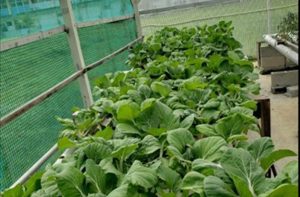Climate-Smart Agriculture is paramount to the work of NAREI, especially since most of Guyana’s agricultural production occurs on the coastland, which is susceptible to flooding. Research conducted by the institute and transfer of technology to farmers is assisting Guyana to meet its obligations to the United Nations Framework Convention on Climate Change (UNFCCC)’s “Koronivia Joint Work on Agriculture” (KJWA).
 The KJWA Roadmap recognised the climate-change challenges –- both adaptation and mitigation –- faced by the agricultural sector and the need for bold, urgent and transformative action to meet these challenges. It also recognised that such action must be led by countries, farmers, researchers, investors and the private sector; and for effective transformation to occur, agriculture must be seen in a broad sense as including policies, services and institutions.
The KJWA Roadmap recognised the climate-change challenges –- both adaptation and mitigation –- faced by the agricultural sector and the need for bold, urgent and transformative action to meet these challenges. It also recognised that such action must be led by countries, farmers, researchers, investors and the private sector; and for effective transformation to occur, agriculture must be seen in a broad sense as including policies, services and institutions.
The thematic area being highlighted this week is: methods and approaches for assessing adaptation, adaptation co-benefits and resilience. This week NAREI in Focus will look at Climate Smart Agriculture, which includes hydroponics and shade-house vegetable cultivation, and the use of solar dryers.
Hydroponics: Globally, agricultural production accounts for 70 percent of freshwater consumption. This water is often supplied through pumps requiring the use of fossil fuels and its consequent GHG emissions. Crop cultivation using a hydroponics system consumes 20 times less water compared to traditional soil-based agriculture and militates against emissions. Other advantages of hydroponic systems over soil-based agricultural systems include the judicious use and recycling of nutrients. Applied nutrients are not leached to the environment to contribute to GHG emissions. Also, the absence of weeds and soil-borne pest and diseases eliminated the use of agrochemicals and their contributions to GHG emissions. Properly implemented, hydroponics gives more produce in less time than soil-based agricultural systems. There is an operational hydroponic facility at NAREI producing pak-choi, lettuce and tomatoes.
 Protected Agriculture: The advent of climate change with its unseasonal wet and dry periods has resulted in increased uncertainty of successful crop production using open-field agriculture. One innovation to adapt to this uncertainty is the use of shade-house cultivations. Shade houses protect plants from insect pests and extremes of weather such as heavy rains, strong winds, extreme heat, and drought owing to climate change. Pesticide use is significantly reduced and its consequent GHG emissions; production cost is lowered, produce is healthier, and production is all year around allowing farmers to take advantage of market seasonality and higher prices. To militate against crop loss owing to flooding from excessive precipitation, stilted grow boxes and raised beds are used for cultivation. There are several active shade houses at NAREI engaged in the production of vegetable crops.
Protected Agriculture: The advent of climate change with its unseasonal wet and dry periods has resulted in increased uncertainty of successful crop production using open-field agriculture. One innovation to adapt to this uncertainty is the use of shade-house cultivations. Shade houses protect plants from insect pests and extremes of weather such as heavy rains, strong winds, extreme heat, and drought owing to climate change. Pesticide use is significantly reduced and its consequent GHG emissions; production cost is lowered, produce is healthier, and production is all year around allowing farmers to take advantage of market seasonality and higher prices. To militate against crop loss owing to flooding from excessive precipitation, stilted grow boxes and raised beds are used for cultivation. There are several active shade houses at NAREI engaged in the production of vegetable crops.
Solar Dryers: Thee solar dryers are operational at NAREI, Mon Repos. These dryers are accessible to the public and are used by farmers to dry vegetable produce. The intent is to encourage farmers and agri-based producers to use renewable energy in their processing operations. The solar dryer ensures that vegetable crops, grains and fruits are protected, dry faster and uniformly, and produces a consistent-quality product. In case of excess unsold agricultural produce owing to market glut, solar dryers can be used to prevent spoilage of fruits and vegetables. These dryers are suitable for hinterland and remote communities where food preservation is paramount.




.jpg)









